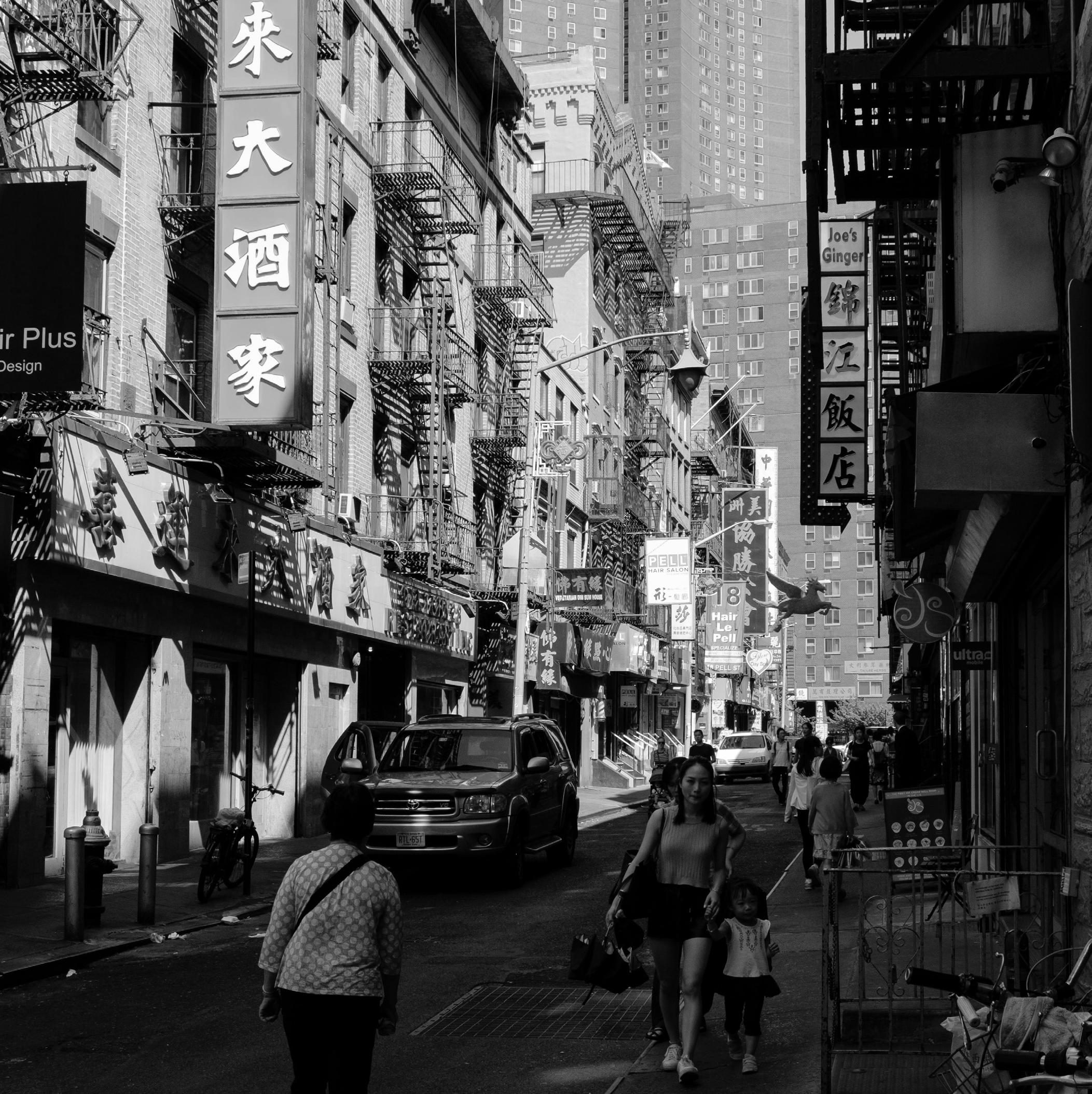MINORITY & WOMEN-OWNED BUSINESSES / MWBEs

IN NEW YORK CITY
Geographic Information Systems
Ruju Joshi | Sharon Mathews
Chinatown, New York
 Photo by Krisztina Papp, Unsplash
Photo by Krisztina Papp, Unsplash


Geographic Information Systems
Ruju Joshi | Sharon Mathews
 Photo by Krisztina Papp, Unsplash
Photo by Krisztina Papp, Unsplash
Scope + Limitations
Methods + Datasets
Section 1: HOW DO MWBEs COMPARE TO ALL BUSINESSES?
Section 2:
MWBEs AND THE FINANCIAL HEALTH OF THEIR NEIGHBORHOODS
Section 3:
MWBEs AND THE ETHNIC COMPOSITION OF THEIR NEIGHBORHOODS
Globally, business ownership is a phenomenon influenced by structural racial and gender disparities. This trend is no different in the United States, where people of color represent about 40% of the population but only 20% of the country’s 5.6 million business owners.1 Women and people of color are limited from starting and growing businesses due to various reasons, including disparities in educational attainment, personal wealth, and access to capital. These factors also translate into missed opportunities for economic growth and entrepreneurship, with their impacts filtering down onto their surrounding communities through the loss of job opportunities, vital neighborhood services, and healthy local economies.
New York has one of the most diverse business landscapes in the country - the state has the highest minority and women-owned business (MWBE) utilization rate in the country 2, while NYC has the highest number of minority-owned businesses per 1000 residents among all major cities in the US3. Minority and women-owned businesses anchor communities and drive equitable growth and employment across NYC’s five boroughs. In this manner, they contribute to the financial health of their neighborhoods, helping them build assets
at an individual- and community-wide scale and contributing to their employment security.
Recognizing this fact, the City of New York has established a variety of initiatives supporting minority and women-led entrepreneurship through the Minority and Women-Owned Business Enterprises (M/WBE) Program. The program was created as an extension of Local Law 129 (2005), which established participation goals for minority and women-owned businesses in City contracts, and Local Law 1 (2013), which allows City agencies to set M/WBE participation goals on standardized, professional, and construction services contracts. A major initiative of the program has been to expand opportunities for minority and women entrepreneurs to access government contracts and grow their businesses.
Through this project, we aim to compare the spatial distribution of MWBEs to that of all businesses in the city; specifically, where their concentrations lie in relation to each other. We will also explore the relationship between the distribution of M/WBEs in a neighborhood and its financial health. Finally, we will compare these clusters of MWBEs with the ethnic composition of their underlying regions. Together, the spatial analysis of these combined datasets will reveal relationships between M/WBEs, the financial health of their neighborhoods, and the ethnic composition of their neighborhoods.
1
The distribution of all businesses in NYC
The ethnic composition of NYC neighborhoods
MWBE
Financial health
Minority and women-owned business enterprise(s)
The financial health of a neighborhood as measured by the Neighborhood Financial Health Index created by the Collaborative for Neighborhood Financial Health (CNFH) and NYC DCA’s Office of Financial Empowerment
Density
Neighborhood Minority Groups
Count of features per unit area
Since the Financial Health Index scores are provided at the Public Use Microdata Area (PUMA) level, PUMAs are considered as neighborhood boundaries here.
Classified as Black, Hispanic, Asian, and others.
New York City Borough Boundaries
NYC Department of City Planning, 2016
Public Use Microdata Areas (PUMAs)
NYC Department of City Planning, 2016
Census Blocks
NYC Department of City Planning, 2016
USGS National Hydrography Dataset (NHD)
U.S. Geological Survey, 2016
Neighborhood Financial Health Digital Mapping and Data Tool
Department of Consumer and Worker Protection (DCWP), 2022
M/WBE, LBE, and EBE Certified Business List
Department of Small Business Services (SBS), 2022
Legally Operating Businesses
Department of Consumer and Worker Protection (DCWP), 2022
2015 American Community Survey 5-Year Estimates
US Census Bureau, 2016
City Contract Dollars Awarded to M/WBEs
Department of Citywide Administrative Services, 2020
The scope of our study is limited to the five boroughs of New York City. We have highlighted certain neighborhoods performing well or badly against our parameters.
Since our study relies on open datasets that are continually updated, it is a contemporaneous study.
The data for City Contract Dollars awarded to M/WBEs is for the year 2020; hence, we will only be tracking the flows of city contract dollars for that year.
For our methodology, we downloaded the data from multiple open data source websites, extracting relevant information using GIS, Python, and Excel. Our data types include spatial data for the geographic boundaries relevant to our study, and non-spatial data, which we converted into spatial attributes using various geoprocessing tools.
Further, we conducted our analysis using spatial joins, Getis-Ord Gi* cluster analyses, and kernel density maps to obtain inferences about the spatial distribution of minority and women-owned businesses in New York City.
Download and Prepare data. (Data Munging using Python) Confirm and correct the co-ordinate system. (NAD 1983 State Plane
M/WBE, LBE, & EBE Certified Business List (NYC)
Legally Operating Businesses (NYC)
Geocode and re-project the locations
Geocode and re-project the locations
Neighborhood Financial Health Digital Mapping and Data Tool (NYC)
Extract Financial Health Index by PUMA
Clip the points by borough boundaries
Clip the points by borough boundaries
PUMA Boundaries (NYC)
Census Tract Boundaries (NYC)
Conduct GetisOrd GI* test for MWBEs per census tract
Identify highvalue clusters
Census Tract Boundaries (NYC)
Calculate and plot the Financial Health Index by PUMA
Conduct GetisOrd GI* test for all businesses per census tract
Identify highvalue clusters
Compare clusters with each other
Compare clusters with NFHI scores by PUMA
The Neighborhood Financial Health (NFH) index relies on several aspects, with the relative distribution of M/ WBEs being just one aspect. The influence / weight of this factor in the overall index calculation may not be strong enough that it influences the Financial Health of an entire neighborhood in isolation (ie: one may not be able to improve the financial health of a neighborhood solely by increasing the number of M/WBEs).
The M/WBE dataset only includes those businesses certified by the City’s M/WBE Program, missing several enterprises which may not be certified by the City. A big reason why many M/WBE owners choose not to pursue certificaton is that the certification process requires a US citizen/permanent resident to be one of the owners of the business, keeping certification out of reach for undocumented business owners. Also, we have only included the M/WBEs with location information in our analysis, which further reduces the number of MWBEs considered in our analysis.
The different geographical boundaries at play - the Getis-Ord clusters by census tract, the NFHI scores by PUMA, ethnic compositions by census tract, and the City Contract Dollars by zipcode - prevents an analysis of all three datasets at once for any correlations. Only two datasets were compared at a time.
The City Contract Dollars dataset does not include the 52% of funds awarded to M/WBE firms with headquarters outside NYC, and is limited in temporal scope to 2020.
 Photo by Kris Graves
Photo by Kris Graves
What is the spatial distribution of MWBEs in relation to that of all businesses?
Geolocating all businesses in New York City, separating them by each borough, and running a Getis-Ord Gi* test reveals where clusters of all businesses lie in each borough.
Total number of businesses: 163,811
Low-value cluster with 99% confidence
Low-value cluster with 95% confidence
Low-value cluster with 90% confidence
Not significant
High-value cluster with 90% confidence
High-value cluster with 95% confidence
High-value cluster with 99% confidence
Cluster of all businesses
The same process is repeated for all minority and women-owned businesses in NYC. The yellow outlines indicate the high-value clusters of all businesses, showing how they differ from clusters of MWBEs.
Total number of MWBEs: 7,257 (4.4%)
Low-value cluster with 99% confidence
Low-value cluster with 95% confidence
Low-value cluster with 90% confidence
Not significant
High-value cluster with 90% confidence
High-value cluster with 95% confidence
High-value cluster with 99% confidence
Cluster of all businesses
 Artwork by Paul Deo
Artwork by Paul Deo
What is the correlation between MWBE clusters and the financial health of their underlying neighborhoods?
By overlaying the outlines of the high-value clusters of MWBEs over the Neighborhood Financial Health scores, we can see if there is a correlation between MWBE presence and financial health.
Borough-wise number of MWBEs within each NFHI score
0.055
$88.9 M dollars worth
$10.44 M dollars worth of contracts
$73.96 M dollars worth of contracts
$7.6 M dollars worth of contracts
$0.47 M dollars worth of contracts
A high concentration or clustering of MWBEs does not account for high scores of neighborhood health in isolation. Additionally, the amount of money received in terms of City Contracts awarded to MWBEs does not have a significant impact on a neighborhood’s financial health.
 Jackson Heights, New York
Photo by Alan Chin, © New York Times
Jackson Heights, New York
Photo by Alan Chin, © New York Times
What do ethnicity-based MWBE clusters look like?
How do they relate to the ethnic composition of their neighborhoods?
MWBEs


Kernel Density
Getis-Ord Clusters
Asian
Kernel Density
Getis-Ord Clusters
Black




Kernel Density
Getis-Ord Clusters
Hispanic
Kernel Density








































Getis-Ord Clusters


































By overlaying the outlines of Asian-owned MBE clusters over a population density map of Asian people, we can see if there is a correlation between Asian-owned MBEs and Asian population clusters.
Total number of Asian-owned businesses: 1,563 (21.5% of all MWBEs)
By overlaying the outlines of Black-owned MBE clusters over a population density map of Black people, we can see if there is a correlation between Black-owned MBEs and Black population clusters.
Total number of Black-owned businesses: 2,595 (35.7% of all MWBEs)
By overlaying the outlines of Hispanic-owned MBE clusters over a population density map of Hispanic people, we can see if there is a correlation between Hispanic-owned MBEs and Hispanic population clusters.
Total number of Hispanic-owned businesses: 1,291 (17.1% of all MWBEs)
Choropleth of percentage of Hispanic people + Clusters of Hispanic-owned MBEs
Total count % of all MWBEs



Asian Black
1,563
2,595
Hispanic
1,291












Mapping the clusters of all businesses in NYC and comparing them to the clusters of MWBEs leads to the following observations:
• In Manhattan, clusters of MWBEs coincide with clusters of all businesses, whereas those in other borough overlap or differ from all-business clusters.
• The cluster of MWBEs in lower Manhattan cover a smaller, more defined region than that of all businesses.
Comparing the clusters of MWBEs with neighborhood financial health scores leads to the following observations:
• MWBE clusters are present in neighborhoods of varying financial health, meaning that there is no significant correlation between MWBE presence and the financial health of neighborhoods.
• The only region where MWBE cluster overlap with high NFHI scores is Midtown Manhattan.
• Similarly, the monetary value of city contracts awarded to MWBEs has no particular correlation with NFHI scores.
Comparing the clusters of MWBEs with ethnicity densities leads to the following observations:
• There are significant differences in ethnicity-based MWBE clusters all over the city, except in midtown Manhattan where there are major overlaps.
• Ethnic MWBE clusters may/ may not overlap with ethnic population clusters, depending on the ethnicity (Black MBEs have significant overlaps) and on the region they’re located in.
Finally, comparing MWBE clusters with ethnicity densities & NFHI scores reveal that:
• While a significant percentage of Asianowned businesses are located in high NFHI zones, the percentage is much lower for Black-owned and Hispanicowned businesses.
• Black and Hispanic-owned business clusters have zero businesses that are both in a neighborhood with a high Black/Hispanic population, and has a high NFHI score.
Graduate School of Architecture, Planning and Preservation
Columbia University, New York
December 2022